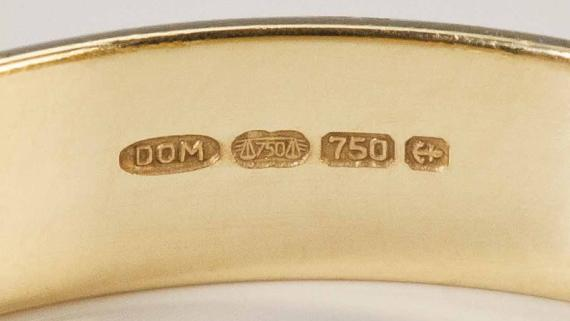The number code for 18K gold is 750. This code represents the purity of the gold, indicating that 18K gold consists of 75% pure gold mixed with 25% other metals to enhance its strength and durability. Here’s an in-depth look at what this number code means and how it applies to 18K gold:
Understanding Gold Purity
Gold purity is measured in karats (K), with 24K being pure gold. However, because pure gold is too soft for most practical applications, it is often alloyed with other metals to increase its hardness and change its color. The karat system denotes the ratio of gold to other metals in the alloy.
- 24K gold is pure gold.
- 18K gold contains 18 parts gold and 6 parts other metals, making it 75% gold.
The 750 Mark
The 750 mark on gold jewelry holds significant importance in the jewelry industry, serving as a reliable indicator of the item’s gold content and overall quality. This mark is not arbitrary; it directly correlates to the piece’s fineness, representing 75% pure gold, which is equivalent to 18 karats. Here’s an expanded look into what the 750 mark signifies and why it matters:
The 750 hallmark is recognized worldwide and is especially prevalent in European and many international markets. It conforms to a standardized system where gold purity is measured in parts per thousand. Thus, when a piece of jewelry is marked with 750, it unequivocally indicates that out of 1,000 parts, 750 are pure gold.
Assurance of Purity
For consumers, the 750 mark is an assurance of quality and purity. When purchasing gold jewelry, buyers want to know they’re getting what they pay for. A piece marked with 750 guarantees that three-quarters of its composition is pure gold, which is particularly important for those with allergies to certain metals that might be used in lower-quality alloys.
Resale Value and Investment
Gold is often seen as an investment, and its purity can significantly affect its value. Jewelry with the 750 mark is highly regarded in the resale market due to its substantial gold content. Investors and collectors alike seek out such pieces for their portfolios, knowing that the intrinsic value of the gold is relatively stable and likely to appreciate over time.
Comparing with Other Gold Standards
Understanding the 750 mark becomes even more crucial when compared to other gold purity marks like 416 (10K), 585 (14K), or 916 (22K). Each of these numbers provides immediate insight into the gold content and can greatly influence the jewelry’s wearability, look, and value. For instance, 18K gold (750) is preferred for its richer color and a better balance between durability and purity compared to 14K (585), which contains less gold and more alloyed metals.
Legal and Ethical Standards
The stamping of the 750 mark on jewelry is not just informative; it’s a legal requirement in many jurisdictions. This marking system helps prevent fraud, ensuring that gold is accurately represented and sold. It also offers consumers a way to hold jewelers accountable, fostering transparency and trust in the jewelry industry.
The 750 mark on gold jewelry is more than just a number; it’s a symbol of quality, assurance, and value. Whether you’re a discerning buyer, a keen investor, or simply someone who appreciates the beauty and longevity of gold, understanding this hallmark is essential. It allows you to make informed decisions, ensuring that the gold jewelry you purchase, gift, or invest in meets your expectations for purity and excellence.
Advantages of 18K Gold
- Durability: The addition of other metals makes 18K gold more durable than pure gold, making it a better choice for jewelry that is worn daily.
- Color Variety: The metals alloyed with gold can affect its color, producing not only the classic yellow gold but also white gold and rose gold, among others.
- Value: While 18K gold is less pure than 24K gold, it strikes a balance between purity, practicality, and value, making it a popular choice for fine jewelry.
Identifying 18K Gold

Identifying 18K gold jewelry accurately requires a keen eye and some basic knowledge about gold hallmarking. Here are five steps to help you ascertain if your piece is indeed 18K gold:
- Look for Hallmarks: The most straightforward way to identify 18K gold is to look for a “750” stamp on the jewelry. This marking, often found in an inconspicuous location, signifies that the gold is 75% pure, or 18 karats. Additionally, you may find other stamps indicating the manufacturer or country of origin, which can further authenticate the piece.
- Examine the Color: 18K gold has a specific hue, richer and deeper than 14K but not as saturated as 24K. While not a definitive test (since colors can be mimicked), this observation, when combined with other factors, can guide your assessment.
- Perform a Magnet Test: Using a strong magnet, you can perform a basic test at home—gold is not magnetic. If your jewelry is attracted to the magnet, it likely contains a significant amount of non-gold material or may be gold-plated. Remember, this test is not conclusive, as non-magnetic metals can also be used in counterfeit pieces.
- Check for Consistent Wear: Genuine 18K gold wears down uniformly over time. If the jewelry shows signs of uneven wear, exposing different colors or layers, it might be gold-plated or of lower purity.
- Seek Professional Verification: If you’re still uncertain about your jewelry’s authenticity or want a definitive assessment, consult a professional jeweler or appraiser. They can perform more sophisticated tests, such as acid tests or electronic testing, which can accurately determine the gold content without damaging the piece.
By following these steps, you can increase your confidence in identifying genuine 18K gold jewelry, ensuring you appreciate its true value and quality.

